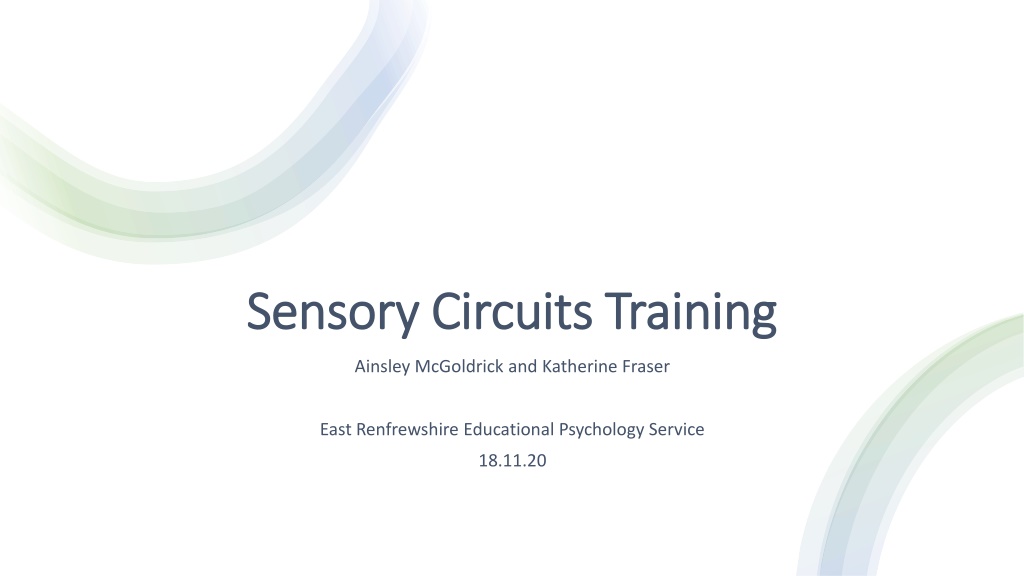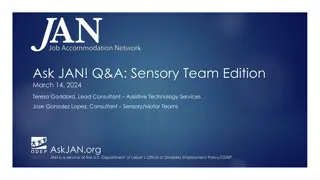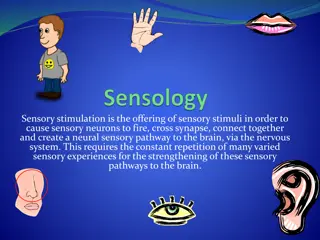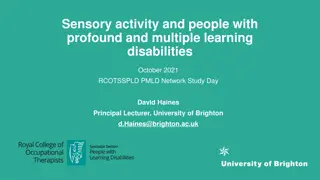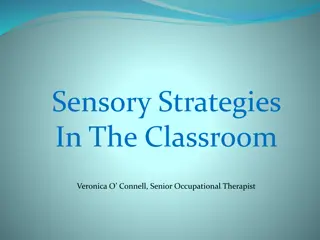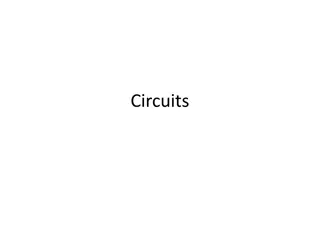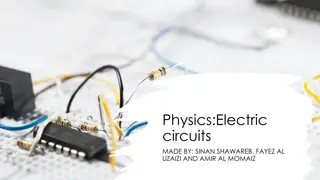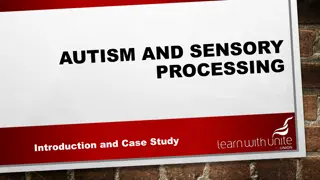Sensory Circuits Training and Integration
Explore the importance of sensory circuits training, sensory integration needs, and the impact on sensory processing. Learn about the various sensory systems, components of sensory integration, and the challenges individuals may face with sensory processing difficulties. Discover strategies to support individuals with sensory needs for improved learning and social integration.
Download Presentation

Please find below an Image/Link to download the presentation.
The content on the website is provided AS IS for your information and personal use only. It may not be sold, licensed, or shared on other websites without obtaining consent from the author.If you encounter any issues during the download, it is possible that the publisher has removed the file from their server.
You are allowed to download the files provided on this website for personal or commercial use, subject to the condition that they are used lawfully. All files are the property of their respective owners.
The content on the website is provided AS IS for your information and personal use only. It may not be sold, licensed, or shared on other websites without obtaining consent from the author.
E N D
Presentation Transcript
Sensory Circuits Training Sensory Circuits Training Ainsley McGoldrick and Katherine Fraser East Renfrewshire Educational Psychology Service 18.11.20
Session Overview The senses and sensory integration needs Why sensory circuits? Setting up sensory circuits Evaluating the impact Questions
8 Sensory Systems Visual (sight) Auditory (hearing) Gustatory (taste) Olfactory (smell) Interoception (internal awareness) Tactile (touch) Vestibular (balance and orientation) Proprioception (muscle and joint movement)
Sensory integration Sensory integration Sensory processing or sensory integration is necessary in order for us to effectively process a wide range of information from our senses. "The neurological process that organises sensations from the body and environment and makes it possible to use the body effectively" (Anna Jean Ayres, 1972) Sensation is like healthy food for the brain. Every sensation nourishes the brain with information and the brain requires a variety of 'sensory food' to develop and function. Our brains develop neural pathways as babies in response to sensory stimulation repeated exposure creates strong pathways which promote healthy sensory integration
5 components of sensory integration 5 components of sensory integration (Williamson and Anzalone, 1996) 1. Sensory 1. Sensory Registration 5. 5. Execution of a response 2. 2. Orientation 4. 4. Organisation of a response 3. 3. Interpretation
When the brain struggles to process, filter or use sensory input efficiently, this can result in the individual receiving confused, muddled or imprecise information about their body and their environment. Misinterpretation of sensory information can negatively impact an individual's availability for learning and social integration. Sensory Processing Difficulties Sensory Integration Difficulties E.g. Hyper/hypo responsive; organisation difficulties; fine or gross motor difficulties; concentration
Over (hyper) Responsive Sensory avoiding It s Too Much Under (hypo) Responsive Sensory seeking I Need More
Sensory Integration Needs What might be going on? Discuss! She can t concentrate on anything He ll only eat breadsticks or crisps He can t sit still it s like his body isn t under his control She will only wear one type of tshirt and all the labels need to come off She hates the school bell her ear defenders help at bell times He hides under the table or in the corner
Sensory Integration Needs What might be going on? Discuss! She bites anyone who upsets her He ll only play if they re doing what he wants He s so lethargic he seems so tired all the time She lies across the table, always slouching, lies on the carpet She seems really clumsy and is always bumping in to things Everything goes in his mouth He flaps his hands when he s excited or upset
We all have certain types of sensations that we dislike and crave- these are unique for everyone We also use various types of self-stimulatory behaviours to maintain attention and relax our nervous system (e.g. hair twirling, chewing pen, tapping feet, rocking) Sensory Integration Sensory based activities can effectively help regulate arousal levels, as well as helping to develop motor skills. Sensory circuits are one way to help energise or settle children.
Sensory Integration Checklist Sensory Integration Checklist To help identify children who could benefit from the circuit programme Set targets to evaluate impact against (e.g. one sensory and one behavioural) Helps identify appropriate activities to include in the circuit
Does the child exhibit difficulties in the following areas compared to same age peers? Yes frequently Sometimes No never Gross Motor Skills Seems lethargic or tires easily Difficulty hopping, jumping, skipping or running Appears stiff or awkward in movements Clumsy, seems not to know how to move body, bumps into things Confuses left and right Hesitant in climbing or playing on playground equipment Reluctant to participate in sports or physical activity Seems to have difficulty learning new motor tasks Struggles with rhythmic activities e.g. clapping, drumming Fine Motor Skills Poor posture when sitting slumps, leans on arm, head close to work, doesn t use non-dominant hand to hold work
Children with sensory integration difficulties tend to seek out or avoid sensory inputs which can lead to difficult or unsafe behaviour or affects their development Many children are not experiencing the sensory rich play environment that many adults remember from their childhood (climbing trees, making dens, puddle jumping .) Why Sensory Why Sensory Circuits? Circuits? We can t fix sensory processing difficulties but we can adapt the environment and our behaviour and help children to become more aware of what they need to help them regulate By providing structured, consistent, repetitive sensory input this can help the nervous system to regulate and reduce sensory seeking or avoiding
Potential benefits of sensory circuits Development of physical/motor skills Improved focus and attention (more settled) Increased self- esteem More engagement Improved self- care skills Communication skills Learning
Sensory Circuits Sensory Circuits Sensory circuits have 3 sections.... 1. Alerting 2. Organising 3. Calming
1) Alerting Section Vestibular activities Jumping and head movement to allow fluid in ears to move. Preparing the brain for learning and demands of the school environment
2) Organising Section Multi-sensory and balancing activities Need to organise the body, plan their actions and multi-task within a set order Aiming to increase focus, attention span and performance in the classroom
3) Calming Section Heavy muscle work and/or deep pressure Ensuring children leave calm, centred and ready for the day
Sensory circuit example video https://youtu.be/IqnnjFwxyqU
Practical Considerations Group size size: Mix of ages and needs is fine. Start small and build up. Staffing: Depends on needs and availability Environment: Larger space is best for spreading out equipment and marking out the stations clearly Frequency: Ideally twice a day (morning and after lunch) for 20-30 minutes Activity timings: 45 seconds per activity (can have as little as 1 activity per section) Circuit variety: Circuit variety: Repetition is important so same circuit every time. Varying levels of difficulty. Risk assessment: Identify potential hazards and precautions/controls to lower any risks
Practical Considerations Flexibility: Respond to the sensory needs you see developing e.g. if Katy likes to spin include more spinning activities Interests: Motivate children by incorporating their interests e.g. if Sam likes dinosaurs, create a dinosaur hunt Have Fun: This might be work for the child s nervous system the child should not think of it as work! Frequency: Ideally twice a day (morning and after lunch) for 20-30 minutes Activity timings: 45 seconds per activity (can have as little as 1 activity per section) Circuit variety: Circuit variety: Repetition is important so same circuit every time. Varying levels of difficulty. Risk assessment: Identify potential hazardand precautions/controls to lower any risks
Take it at each child's pace and adapt activities where necessary Monitoring and Reviewing 'Official' half-termly reviews are recommended Triangulating evidence (staff, parents/carers and pupils)
